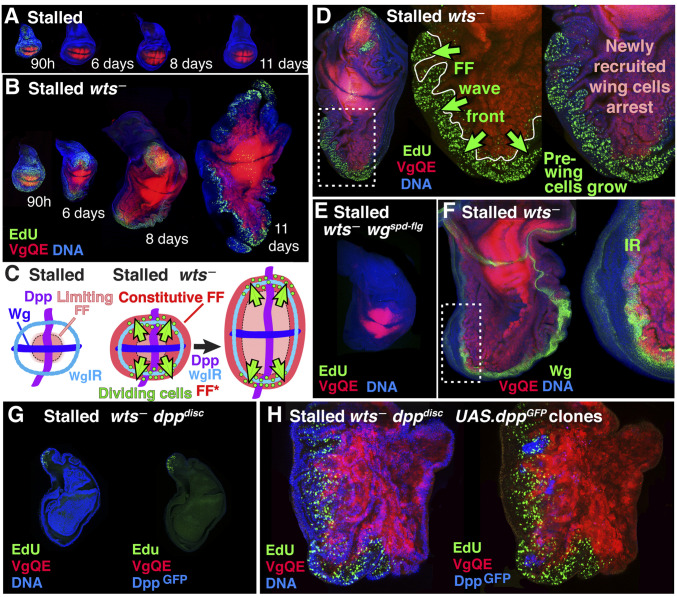Fig. 4.
Constitutive Yki activation sustains morphogen-dependent growth and recruitment of pre-wing cells. (A and B) Constitutive Yki activity sustains FF growth in stalled discs. In contrast to wing discs of phm.lexA:VP16 LexOP.fhRNAi but otherwise wild-type larva, which stall after ∼6 to 7 d (A), wing discs from phm.lexA:VP16 LexOP.fhRNAi larvae that are homozygous for the wtsP2 mutation have constitutive Yki activity and show continuous proliferative growth of cells at the wing periphery (monitored by EdU incorporation, green, in both A and B), as well as a dramatic expansion in the wing proper, primarily in the D/V axis (5XQE.DsRed, red). As observed for blanket Dpp and Wg expression in stalled discs, growth is restricted to the wing periphery: Once cells initiate vg expression and enter the expanding wing primordium they arrest. (C–F) Continuous FF growth in stalled wtsP2 larvae depends on Wg produced by IR cells surrounding the wing primordium. (C) In wtsP2 stalled discs, wing growth by FF propagation should be limited only by the availability of Dpp and Wg but is observed far outside of the expected range of Wg produced by D/V border cells. However, IR cells (WgIR, light blue) provide a second, potential source of Wg. In stalled but otherwise wild-type discs, we envisage that pre-wing cells that are in position to receive this Wg as well as Dpp do not respond because they are located too far from the wing proper to receive FF signal. By contrast, in stalled wtsP2 discs, these pre-wing cells should now receive constitutive FF input in addition to Wg produced by IR cells and hence should continue to grow and be recruited into the wing, provided they also receive Dpp. As observed (D and F), it is specifically non-Vg-expressing cells in the immediate surround of the expanding wing primordium that are exposed to Wg from the IR (F, green, IR) and continue to proliferate (D). No wing growth is observed in wing discs from stalled, wtsP2 larvae that are also homozygous for wgspd-flg, an enhancer mutant allele of wg that selectively eliminates Wg expression in IR cells (E), confirming that these cells are the source of Wg responsible for the continuous growth at the wing periphery in wtsP2 stalled discs. (G and H) Continuous wing growth in stalled wtsP2 discs depends on Dpp. No growth is observed in stalled, wtsP2 wing discs that are transheterozygous for two dppdisk enhancer mutant alleles, dppd8 and dppd10, that abolish Dpp expression in the wing disc (G); however, continuous growth can be reinitiated in such discs by heat-shock-induced excision of the stop cassette of an Act > stop > Gal4 transgene to generate clones of UAS.dppGFP cells that ectopically express a GFP-tagged form of Dpp (H, blue; SI Appendix).

